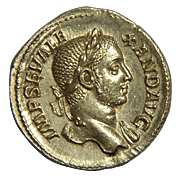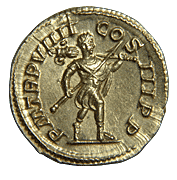 |

Gold aureus, Roman emperor
Grade: good EF / Price: $4,750
 |
 |
Obverse: IMP SEV ALEXAND AVG, laureate bust of emperor right, drapery on left shoulder. Reverse: P M TR P VIIII COS III P P, emperor, as Romulus, clad in military attire, hurrying right, holding transverse spear and trophy over shoulder. References: RIC 103; BMCRE 620 and pl. 21.
Born in Phoenicia in AD 208 M. Julius Gessius Alexianus was the son of Julia Mamaea (niece of the Empress Julia Domna) and Gessius Marcianus. On the elevation of his cousin Elagabalus to the Imperial throne (AD 218) he came to Rome with the rest of the Imperial family but remained very much in the background. However, when his grandmother Julia Maesa perceived that the future of the dynasty was being threatened by the outrageous behavior of Elagabalus the young Alexianus was brought more into the public limelight and was even granted the title of Caesar (AD 221). On the murder of his cousin the following year the 14-year-old Caesar was immediately hailed as emperor under the name of Marcus Aurelius Severus Alexander. His reign saw a complete change from the wild excesses of the previous regime and an atmosphere of quiet dignity was restored to government circles in Rome. However, the extraordinary influence wielded by the emperor's mother, Julia Mamaea, caused much resentment , especially amongst the military, and boded ill for the long term prospects of the dynasty . Meanwhile, the storm clouds were gathering on the Imperial frontiers and in AD 231 Alexander, despite his lack of military experience, was obliged to proceed to the East where the Parthian Empire had recently been overthrown by the dynamic new Sassanid dynasty. The campaign was moderately successful, but soon after the emperor's return to Rome he was required to take the field again, this time on the Rhine frontier where the German tribes were threatening the security of the area. His overtures of peace to the barbarians aroused much anger in the Roman army and ultimately led to a mutiny in which both Alexander and the Empress Mamaea lost their lives (March, AD 235). This beautiful gold aureus, the most valuable regular denomination in the Roman coinage, is dated by the 9th year of the emperor's tribunician power to AD 230. The type of the emperor depicted as Romulus, the legendary founder of Rome, may be seen as an attempt to emphasize the traditional values of the current regime in marked contrast to the oriental decadence of the previous reign. Additionally, it may even have looked forward to Rome's forthcoming thousandth anniversary which was just 17 years away. With the emperor only 22 years of age it might have seemed a fairly confident prediction that he would still be occupying the throne at the commencement of the millennium celebrations in AD 247.
 |
 |

